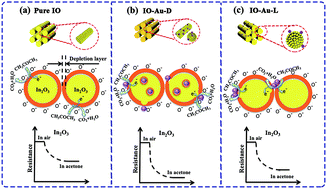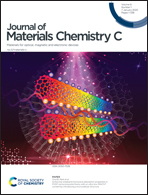Revealing the relationship between the Au decoration method and the enhanced acetone sensing performance of a mesoporous In2O3-based gas sensor†
Abstract
In this study, long-term ordered mesoporous In2O3 was prepared by replicating the structure of SBA-15. Samples prepared with Au-doped and Au-loaded mesoporous In2O3 were aimed at studying the influence of the modification method (doping and loading) on acetone sensing properties, and the corresponding sensing mechanism was discussed in detail. The structural and chemical characterizations of the samples were carried out by XRD, BET, TEM and XPS. The best sensing performance was achieved in the In2O3 Au-doped (IO-Au-D) sample; the response reached 19.01 to 100 ppm of acetone at 250 °C. The effects of the polarity and bond dissociation energy of acetone benefited the improved selectivity among volatile organic compounds (VOCs). The excellent gas sensing performance not only depended on the ordered mesoporous structure of the In2O3 matrix, but could also be attributed to the “electronic sensitization” and “chemical sensitization” of Au. Furthermore, uniformly dispersed Au doping depressed the lattice growth and enlarged the depletion region, playing a great role in enhancing the sensing performance. However, the limited surface decorated region of the Au-loaded sample suppressed the enhancement of the acetone sensing performance. This work significantly reveals that the sensing performance can be controlled by different methods of introducing additives.



 Please wait while we load your content...
Please wait while we load your content...